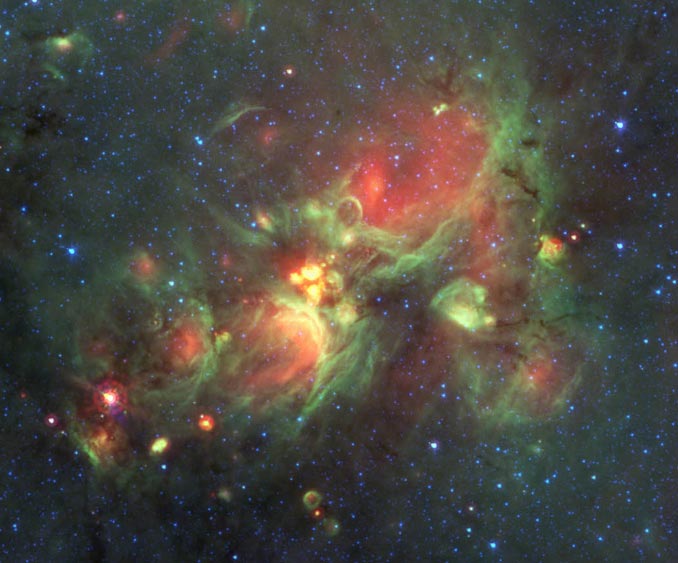Stellar Astronomers Answer Question Posed by Citizen Scientists: ‘What Are Yellowballs?’

Image courtesy of NASA/JPL-Caltech. Citizen scientists working with the Milky Way Project noticed and tagged the "yellowballs" in the middle of this image from the Spitzer Space Telescope.
“Any ideas what these bright yellow fuzzy objects are?” the volunteer wrote on a project message board.
Well, that sparked some discussion among the professional astronomers on the Milky Way Project and eventually led to a study of the compact objects now known as “yellowballs.” A paper just published by The Astrophysical Journal (“The Milky Way Project: What are Yellowballs?”) answers some questions about the 900 yellowballs tagged by citizen scientists.
Charles Kerton, an Iowa State University associate professor of physics and astronomy and a member of the Milky Way Project science team, is first author of the paper. Co-authors are Grace Wolf-Chase of the Adler Planetarium in Chicago and the University of Chicago; Kim Arvidsson, formerly an Iowa State doctoral student and now of Schreiner University in Kerrville, Texas; and Chris Lintott and Robert Simpson of the University of Oxford in the United Kingdom.
“In this paper, through a combination of catalog cross-matching and infrared color analysis, we show that yellowballs are a mix of compact star-forming regions,” the astronomers wrote.
And, they wrote, the project demonstrates “the serendipitous nature of citizen science efforts” because Milky Way Project volunteers “went beyond their assigned tasks and started tagging and discussing” the yellowballs.
The Milky Way Project is part of the Zooniverse, a collection of Internet-based science projects that ask for the public’s help looking through images and other data.
The Milky Way Project asks people to study tens of thousands of Spitzer’s infrared images. People are asked to circle and classify various objects, including bubbles of gas and dust blown by the radiation and charged particles from bright young stars.
To date, citizen scientists have made nearly 1.5 million classifications for the project.
Kerton said all of that classifying is helping astronomers study and map star formation within the galaxy.
But the project took a little detour when citizen scientists noticed yellow objects along the rims of some bubble formations. (It should be noted the yellowballs found in Spitzer’s infrared images aren’t really yellow. When the images are made, various colors are assigned to represent different wavelengths of infrared light. The yellow color on the images highlights where infrared emission from molecules (colored green) and from hot dust (colored red) completely overlap.)
The astronomers began studying those yellowballs by cross-matching them against existing catalogs of space objects. They also studied the luminosity and physical sizes of 138 of the yellowballs.
Kerton said the researchers found most of the yellowballs were located in regions of the galaxy containing dense gas. They also found that yellowball luminosity was consistent with the luminosity expected for a collection of newly formed massive stars.
They’ve concluded there’s an early “yellowball stage” in the formation of stars 10 to 40 times as massive as our sun. The yellowballs are considered very young versions of the bubble formations.
“All massive stars probably go through this yellowball stage,” Kerton said. “The most massive stars go through this stage very early and quickly. Less massive stars go through this stage more slowly.”
The astronomers also wrote that further studies of yellowballs will improve our understanding of how regions of massive star formation grow from early compact stages to more evolved and bubble-like structures.
But those findings aren’t the only highlight of this particular study, Kerton said.
“The fun thing about this study is the involvement of the citizen scientists,” he said. “This is a nice example of people looking at something in the universe and saying, ‘That’s different,’ and then passing it on to professional astronomers.”
Contact Information
Charles Kerton, Physics and Astronomy, 515-294-2298, kerton@iastate.edu
Media Contact
More Information:
http://www.iastate.eduAll latest news from the category: Physics and Astronomy
This area deals with the fundamental laws and building blocks of nature and how they interact, the properties and the behavior of matter, and research into space and time and their structures.
innovations-report provides in-depth reports and articles on subjects such as astrophysics, laser technologies, nuclear, quantum, particle and solid-state physics, nanotechnologies, planetary research and findings (Mars, Venus) and developments related to the Hubble Telescope.
Newest articles

NASA: Mystery of life’s handedness deepens
The mystery of why life uses molecules with specific orientations has deepened with a NASA-funded discovery that RNA — a key molecule thought to have potentially held the instructions for…

What are the effects of historic lithium mining on water quality?
Study reveals low levels of common contaminants but high levels of other elements in waters associated with an abandoned lithium mine. Lithium ore and mining waste from a historic lithium…

Quantum-inspired design boosts efficiency of heat-to-electricity conversion
Rice engineers take unconventional route to improving thermophotovoltaic systems. Researchers at Rice University have found a new way to improve a key element of thermophotovoltaic (TPV) systems, which convert heat…



